
Recently Katie, who is in her 20’s, wanted to make a curtain for a bedroom window. She went to a large retailer to look for and choose the material for it. But, she found it so over-whelming that she left. She did not know what was suitable, how much she would need, and there was no one to help her.
We decided that people who had never made anything with home decorating fabric might want some help. So, step by step… let us proceed!
THINK USE
First, the fabric one chooses for a project should depend totally on the use it will get. One often sees fabric one loves, but if the fabric is not correct for the end use of what one is making, buy some for a pillow. Forget about using it incorrectly, as you will not be happy down the road. For instance, using a very light weight fabric for a sofa used by children and dogs for TV is not a good idea, as it will not last. At the opposite end of the fabric spectrum- using a very heavy weight upholstery fabric for a duvet cover might result in someone being flattened during the night.
While this seems like common sense, it is easy to get pulled into using a fabric that will not work out. The intended use should be the guiding force when choosing fabric.
Katie wanted to make a curtain
for a bedroom window.
And she was quite specific about the look she wanted-
two panels, one on either side of the window.
She also knew she wanted to hang them by a pocket with a rod.
This meant she had a very wide choice
of fabric weights.
So, the next thing was to consider different fabric types.
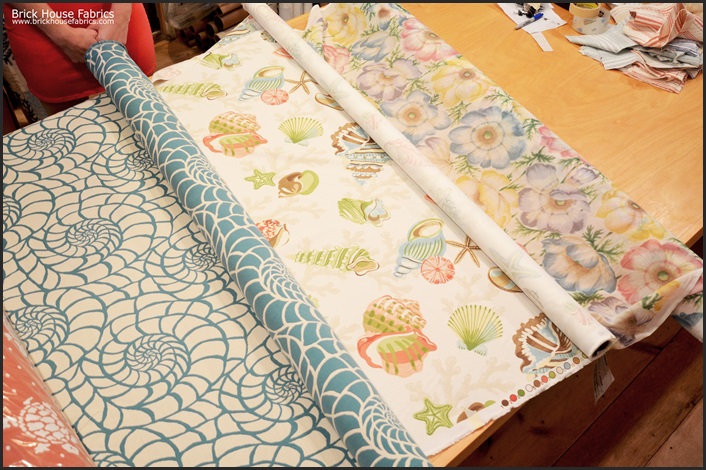
Three bolts of fabrics were pulled at random for Katie to see.
There was a sheer floral, a mid-weight shell,
and a heavy reversible upholstery weight modern shell fabric.
Katie did not want a sheer,
as the room needed to be dark.
And she did not like the look of the heavy upholstery weight fabric.
So, the mid-weight home decorating fabric was the weight she was looking for.
WHAT IS HOME DEC FABRIC?
Home dec, or home decorating fabric is, at its most basic, fabric used for decorating the home. It is broken into different genres. These are sheers, mid-weight, upholstery weight, and indoor/outdoor. There are a few other categories, such as lace, but those are the basics.
Home dec fabric is normally 54 – 56″ wide. The reason for the width of home dec fabric is so a section of a couch can be covered in one piece, without a seam.
There are some variables. The European mills often have fabric woven at 64″, nearly a full foot wider. And many weave a double width fabric of around 111″, which either gets cut down the middle or is folded and rolled. There are also some American and Japanese companies that make quilt weight fabric that print on a heavier weight cloth with a width of 45″. But as the norm for home dec weight fabric is around 54″ wide, we will be talking about fabric that is that wide or wider.
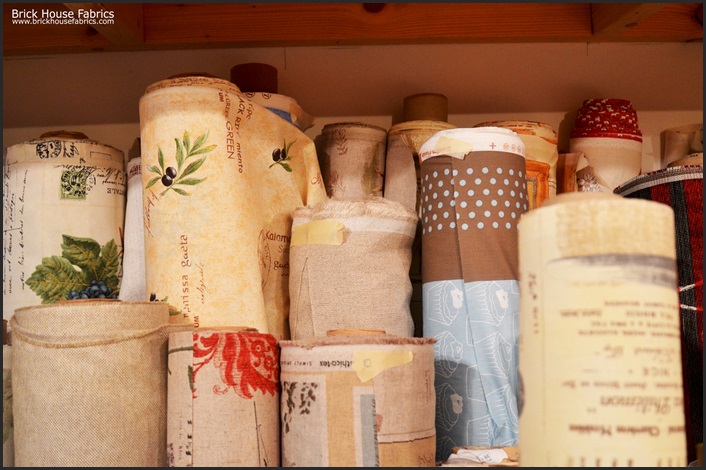
Bolts of cloth-
the French extra wide fabrics standing tall!
CHOOSING THE FABRIC
The next step for Katie
was to start looking for a pattern
she thought she might like!
There was one consideration- the color of the bedroom walls.
They are a dark greenish tone.
So, it was either find something that would work with it,
or else paint the walls.
I feel a person should wake up to something that they really like,
rather than picking a fabric that they feel will “work”.
That is, after all, what Brick House Fabrics
is all about- using fabric that one likes, that makes one happy!
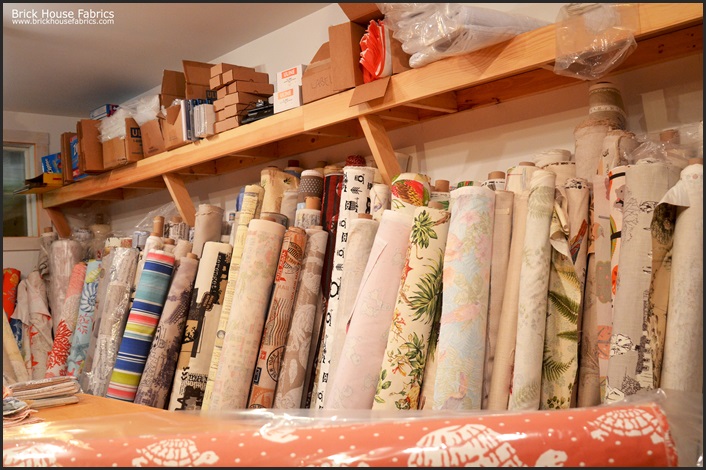
We have a lot to look at!
The bolts are organized by genre-
all of the ocean fabrics together, all of the toiles, etc.
Katie really did not know which direction she want to go,
so we started by just randomly pulling out bolts.
Tentative at first,
Katie soon started moving the bolts around.
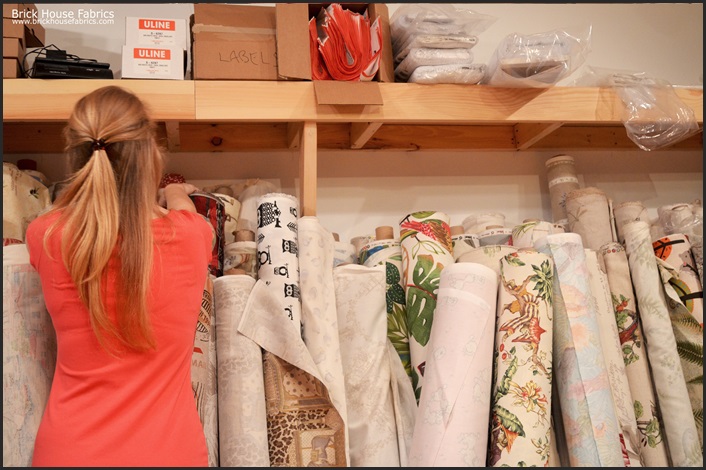
It soon became clear that Katie likes reds and pinks,
so we concentrated on those colors.
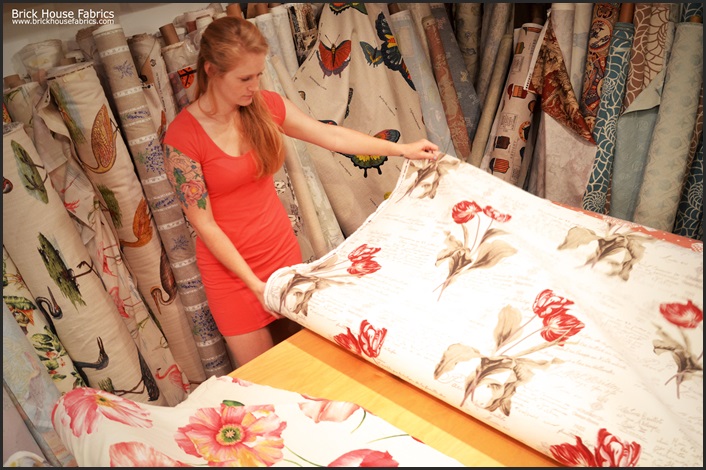
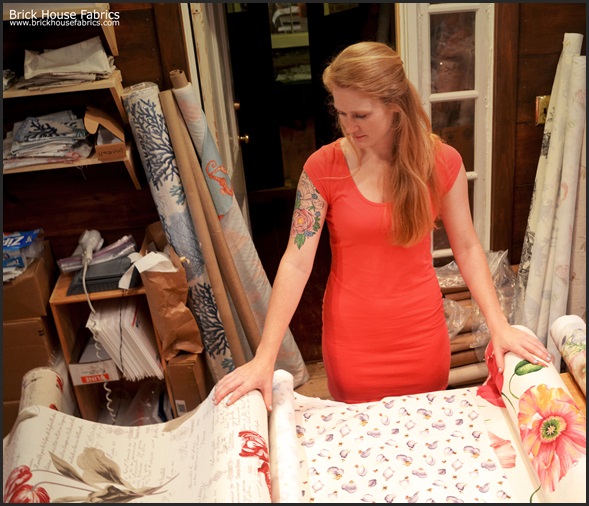
Katie had definite tastes…
She liked the large scale
of the Paris tulip fabric and the anemones.
Though she liked the purple rose petal fabric, she felt the scale was too small.
She also compared the hand,
and texture of the fabrics.
The anemone fabric is woven with a slub,
and has nice drape.
The lavender rose petal fabric has a corded weave.
And the Paris tulip fabric, though smooth, has a very tight weave, making it a bit stiff.
SPIN and WEAVE
The hand, the feel, and the drape of a fabric depends on several things. The first is the fiber- what is it woven of? Is the fiber a long staple fiber, making the thread a smoother thread? Or does it have lots of ends, like a silk spun with noils? The fiber and the spin effect the fabric’s look and feel, how it moves and drapes.
The actual spin of the thread, as well as the fiber, effects the fabric. Is it a heavy thread? Or is it very fine? Is it spun with a slub- which is thick and thin? Or is it a smooth thread? Is it a tight spin or a loose spin. All of these factors influence the finished fabric.
Then there is the weave. There are many, many different weaves
A basket weave is used from everything from handkerchiefs to heavy upholstery fabric. What influences the outcome is the fiber, the spin, the thread size, the tightness of the weave. Take the twill weave- one sees it often. Using a tightly spun thread with a tightly woven twill weave, and one will have a tight dense fabric, with some give, like blue jeans. Weave it slightly more loosely with a lighter thread and one will have a totally different fabric, one with a lot of drape.
The integration of the fiber, thread, and the weave not only effect the look and feel of the fabric, but also the dying process. Different fibers dye differently. And the different thread spin and cloth weaves effect the way fabric accepts dye.
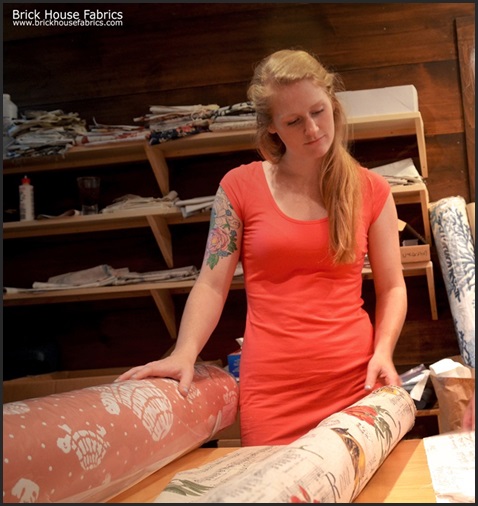
Katie considers the
Bird Paris Music fabric.
Katie also looked at some more traditional fabric patterns,
but felt they were too what I call “Auntie”.
Just as important in choosing fabric and, actually, anything else,
is the process of elimination.
By knowing what you DON’T want,
one begins to know what one DOES want.
She knew she did not want anything ocean related,
as the house was not on the shore, and had nothing of the ocean in it.
And, by the process of elimination,
we were able to remove small patterned designs,
and more the more traditional patterns of toiles and florals.
Katie ended caught between the very large anemone flower fabric,
the Paris tulip fabric,
and the Paris music fabric.
With green walls to contend with,
samples were imperative!
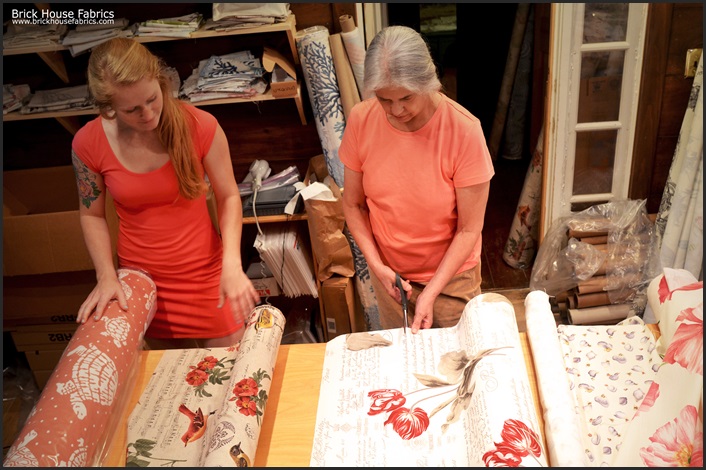
So, Katie went home,
samples in hand,
to consider the three fabrics in her own house,
with its own light.
SAMPLES
Samples are a necessity. Even if one is buying fabric in a brick and mortar store, they are important. Light between locals changes dramatically. The difference in light between Paris and New York City, or the Florida coast and the mountains of Wyoming is dramatic.
Lights, walls, and other nearby colors influence how color is appears. Even the time of day one is viewing things influences how color is perceived. Blues, for example, are more predominate in the late afternoon and evening. So, get a sample to see what a fabric looks like where you wish to use the fabric!
MANTRA-
Get a sample!
Katie will be back soon to finalize her purchase,
and then go on to sew the curtains!
We will keep you posted!
_________________________________________________________
PLANNING THE PROJECT
_________________________________________________________
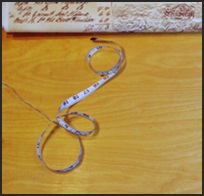
Katie came back the next week, to discuss the particulars of the curtains. I had to be gone for part of the discussion, but Christine, an excellent sewer, took over.
The first thing to discuss was how Katie wanted the finished curtain to look, and how to achieve that was the goal of the day!
Katie wanted the curtain to be two panels. They were to be hung on a rod, so she needed a pocket, and she wanted a slight header on top of the pocket to block out light. And it was an inside mount.
The window is 30″ wide x 54 1/2″ long, measuring the inside of the windows moldings. They decided that the header should be 1 1/2″ and the pocket 1 1/2″. They decided to not hem it until the panels were hung, as Katie lives in an old house- built in 1853, and in old houses, nothing is level. They curtain hems would need to be measured and pinned after they were first hung to make certain they were even with the window sill. The sides were to be a turned hem of 1″.
Katie had decided on the
French tulip fabric.
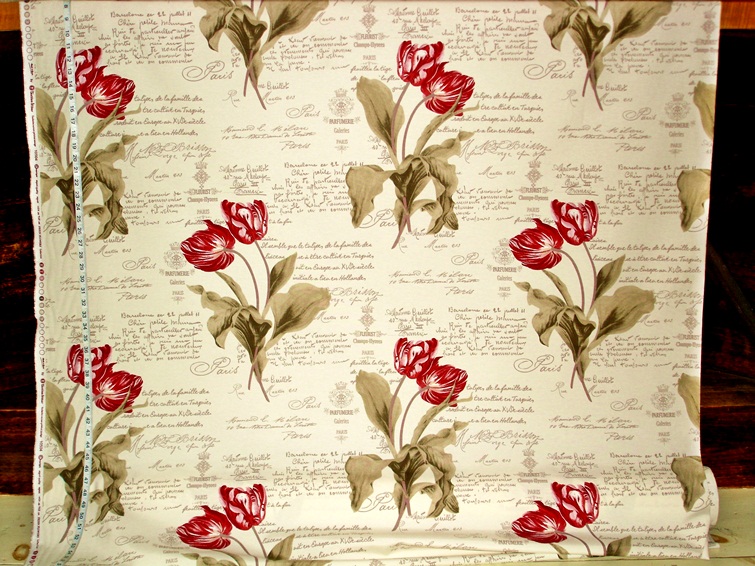
This fabric has a perfect pattern set up for this project!
Cutting the fabric down the middle of the print will give two matching panels.
Easy, peasy!
LESSON 1
Pattern Placement
Look at the pattern set up and placement.
One of the reasons we have an over-all picture on every fabric listing is so a person can see the fabric pattern placement.
It is impossible to know how to best use a fabric without knowing how the pattern sets up!
While this fabric has a pattern with an easily seen design setup, some patterns are staggered, and some only have the full pattern design on the right side of the fabric, the left having a partial part of it.
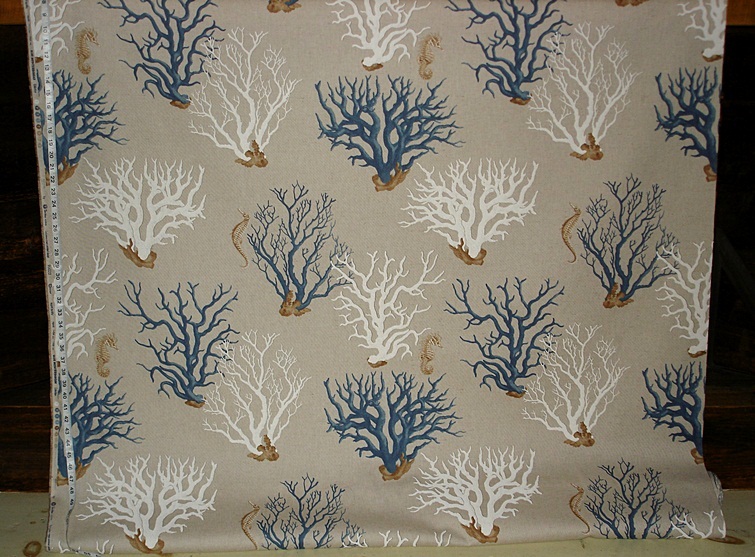
The very popular blue coral seahorse fabric has a seahorse that everyone loves- the small rounded one. But, if one wanted to use that in the center of a curtain panel, like Katie is doing with the tulip fabric, they would have to have twice the length of fabric, due to the placement of that seahorse. While the one on the right is quite useable, the one on the left is so close to the edge of the fabric that it is not.
In this instance it would be better use of the fabric to cut down the middle, as Katie is, and have the coral trees running down it, centered, with the two different seahorses not used as the main feature, but part of the over-all theme of the fabric.
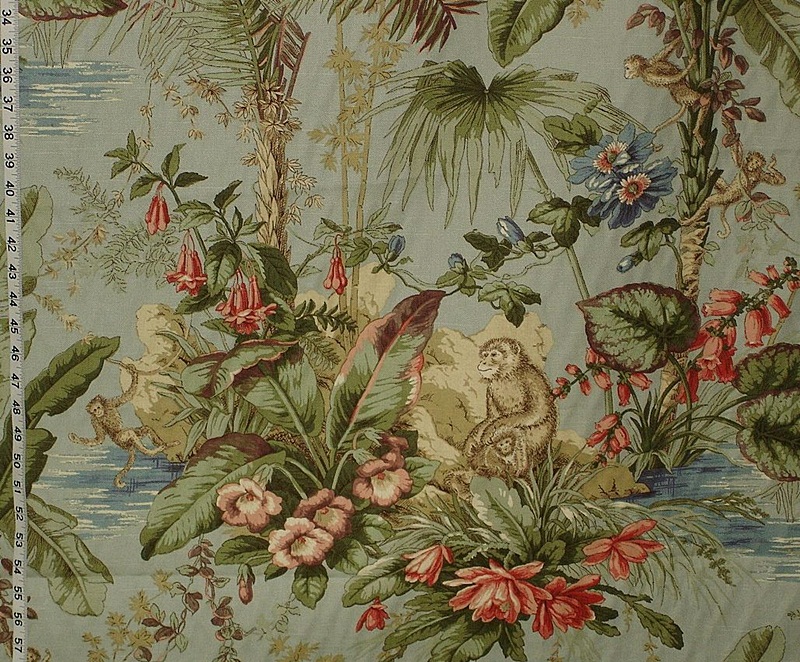
A different pattern set up is shown in what we called the Monkey Mama fabric. This pattern featured a large scene of a mama monkey and family, which is staggered on the fabric.
One assumes that each of the scenes is complete. But, look closely at the left hand side of the over-all picture.
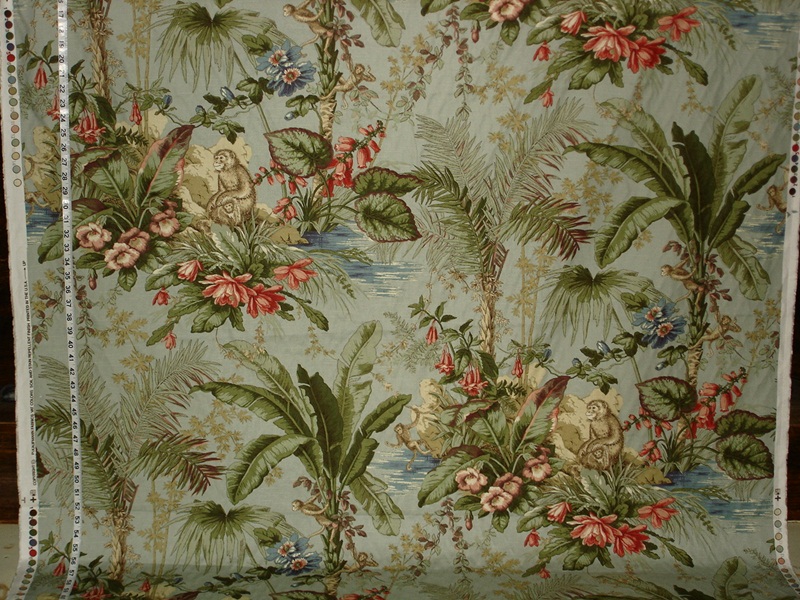
The left hand scene is not complete. It is missing the small monkey that is leaning out over the water. Only the right hand scene is complete. If one wanted to include that small mischievous monkey in the project, one would need twice the length of fabric to do so.
So, look at the pattern placement for your project. And carefully consider how to best use it. If there is a particular pattern element you wish to highlight, make note of where it lies on the fabric- how close to the selvedge it is and whether it repeats horizontally…these are things you will want to know as you move forward with your project.
_________________________________
After Katie and Christine had discussed what she needed and wanted for the curtains,
we met to look at her fabric.
We wanted to make certain that the design placement
would fall where she wanted them on the panels.
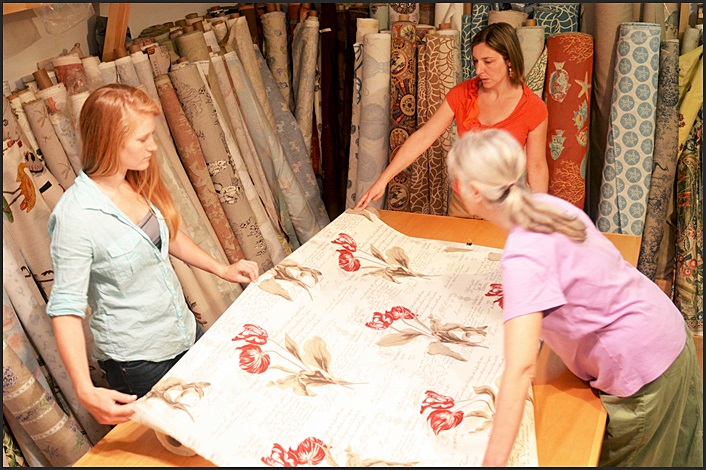
We went over the measurements again,
checking that the amount of fabric
allowed for hems, header, pocket, and length
were correct.
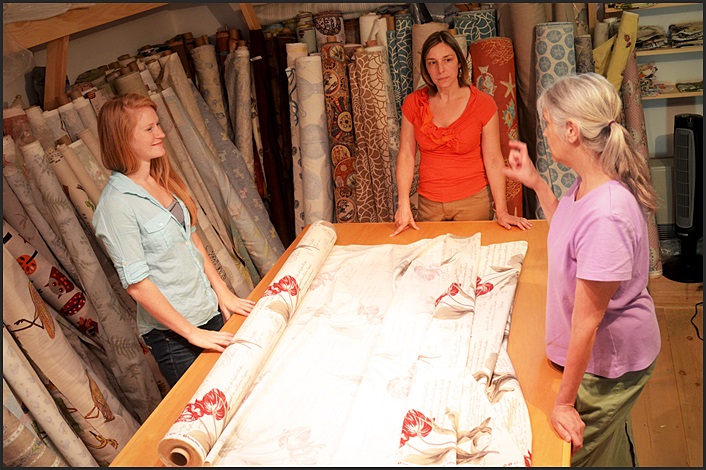
The pattern of the fabric is 55″ wide.
So, cutting it down the middle, gives 27 1/2″ to work with for each panel.
The side hems will take up 2″ per side, a total of 4″ per panel,
leaving the panel 23 1/2″ wide.
Most curtain panels are 1 1/2 times the width needed.
The window is wide,
1/2 of it is 15″, and 1 1/2 of that is 22 1/2″.
So, this is just perfect!
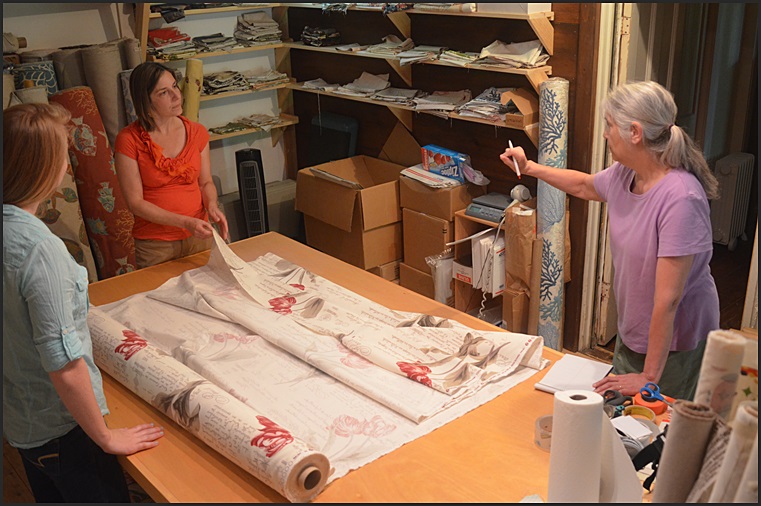
After a bit more discussion
we were ready to measure out the fabric!
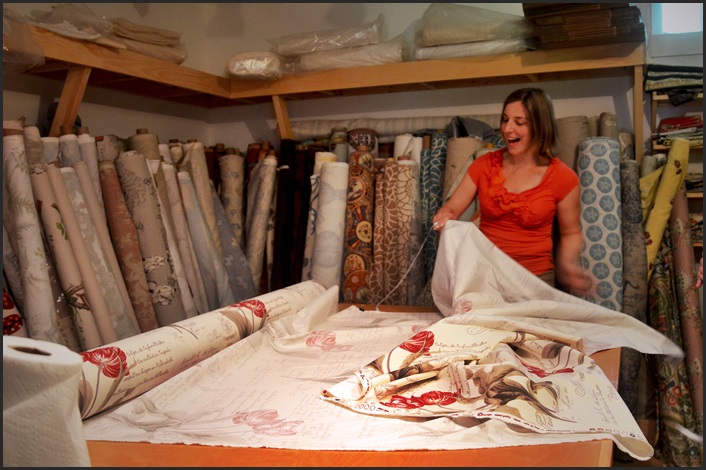
Go Christine!
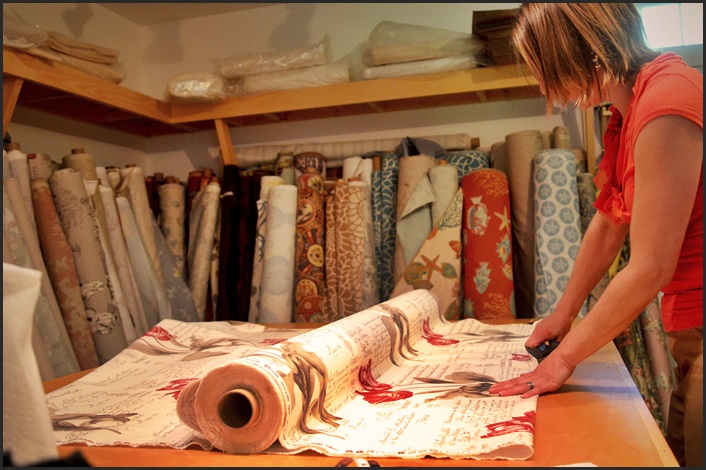
The fabric is cut and folded for Katie to take home.
Katie needed a part for her sewing machine that had to be ordered.
Once it arrives, she will start work on the curtains!
We will keep you posted!
